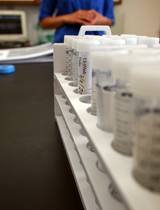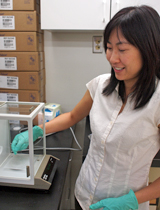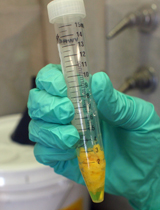Producer Gisela Telis revisited Loh's lab and UA research on arsenic for AZ Illustrated Science in 2014. Watch now:
In Miranda Loh’s lab, toenails are telling stories. They arrive in little brown envelopes almost every week, sometimes in batches of three or four, sometimes by themselves.
And together, they’re piecing together a puzzle that could affect the health of more than a million Arizonans.
 Miranda Loh's lab uses toenail clippings to measure arsenic exposure among rural Arizona water users.
Miranda Loh's lab uses toenail clippings to measure arsenic exposure among rural Arizona water users.Loh, an assistant professor of environmental health sciences at the University of Arizona Mel and Enid Zuckerman College of Public Health, is trying to measure Arizonans’ exposure to arsenic over time.
It’s an important question because Arizona residents get more than their share of the common but poisonous chemical element.
The state has naturally occurring high concentrations of arsenic in its soil and groundwater, particularly in the central part of the state. There, groundwater concentrations of arsenic can exceed the 10 parts per billion (ppb) standard for safe drinking water.
Exposure to high levels of arsenic is known to cause health problems ranging from cancer to heart disease, says Todd Camenisch, an associate professor in the University of Arizona College of Pharmacy who has studied arsenic’s effects on cardiovascular health as part of the UA Superfund Research Program.
“This is such an old poison, yet we’re still studying its effects,” says Camenisch. “But we know it can be a serious problem.”
Camenisch’s research so far suggests that even low levels of chronic arsenic exposure—levels around or slightly above the 10 ppb standard—can harm heart cells and take a toll on human health.
Now, Loh’s work aims to determine exactly how much arsenic Arizonans are getting, and how it’s affecting them over time. To do that, she and her colleagues have taken the word about arsenic to a cohort of about 50 rural residents.
Rural water users with private wells face the greatest risks of exposure, because they draw their water directly from contaminated groundwater basins and may not regularly test and monitor the water they draw. Many weren’t aware of the arsenic problem until they were contacted for the study, Loh says.
 Researcher Miranda Loh hopes to shed light on Arizonans' arsenic exposure and its toll on human health over time.
Researcher Miranda Loh hopes to shed light on Arizonans' arsenic exposure and its toll on human health over time.“It came as a surprise to some of our participants,” she explains. “They may have heard people talk about it, but they didn’t worry enough to change their behavior or check their wells. So it will be useful for them to know what we find.”
The would-be participants were asked if they use their wells year-round and how frequently they drink their well water. Then, Loh got to the personal stuff: she asked for their toenail clippings.
“I don’t even know how I got into the toenail thing,” Loh laughs. “But hair, nails, blood and urine are all biomarkers that tell us about arsenic exposure.”
Blood and urine are the best biomarkers, or indicators, for exposure, but because human bodies can get rid of arsenic fairly quickly, these fluids can only reveal exposure over a span of days.
Slow-growing hair and nails reveal exposure over months, giving Loh the opportunity to tease out variations in exposure through the seasons and track them over time.
 Nitric acid breaks down or "digests" toenails so scientists can analyze their chemical composition.
Nitric acid breaks down or "digests" toenails so scientists can analyze their chemical composition.The well owners agreed, and most have been sending out their shorn nails regularly for the past three months. After they arrive in the lab, they’re measured and weighed, thoroughly washed and then dropped into test tubes filled with nitric acid.
The acid breaks down the clippings so a machine can read their chemical make-up. When they know how many micrograms of arsenic are in each gram of toenail, Loh and her colleagues can calculate how much arsenic is accumulating in each participant’s body.
Once they have enough data to answer that question—and Loh expects to collect and process data through the summer—Loh’s team will share the results with the participants, along with guidance on how to protect themselves from exposure if they need to.
Concurrently, the Superfund Research Program will be working on techniques that can keep arsenic out of groundwater in the first place.
“We’re not just going to say, ‘Look, you have this problem,’” says Camenisch. “We try to find solutions too. We want to improve the health of all people in Arizona.”

By submitting your comments, you hereby give AZPM the right to post your comments and potentially use them in any other form of media operated by this institution.